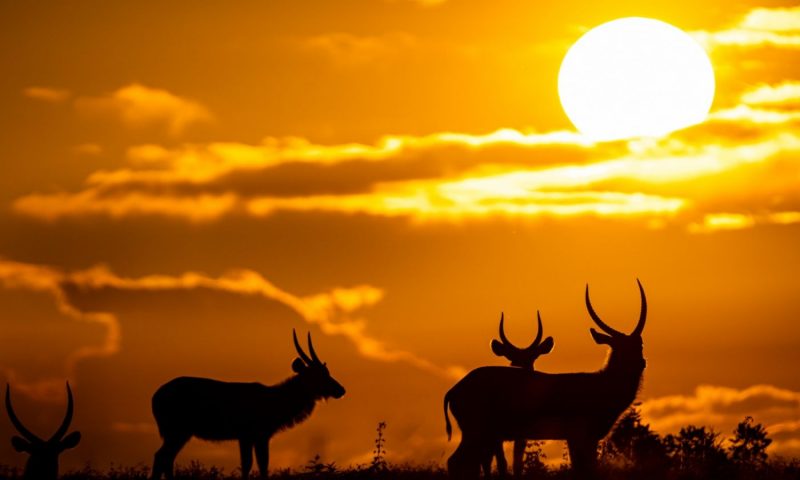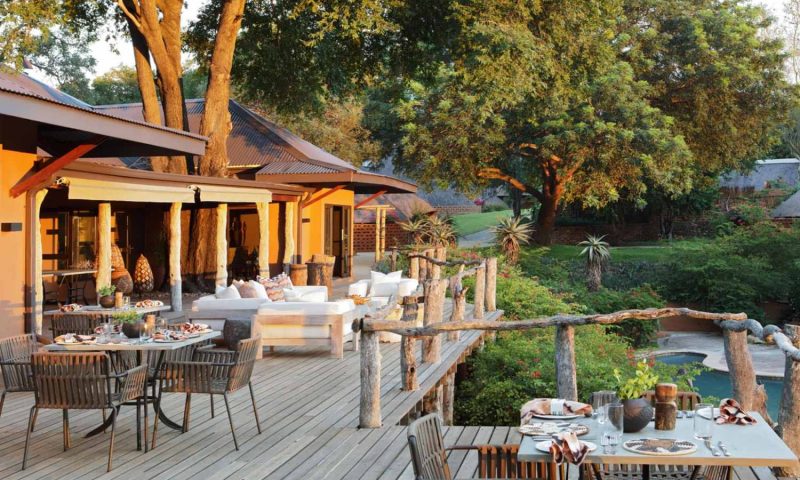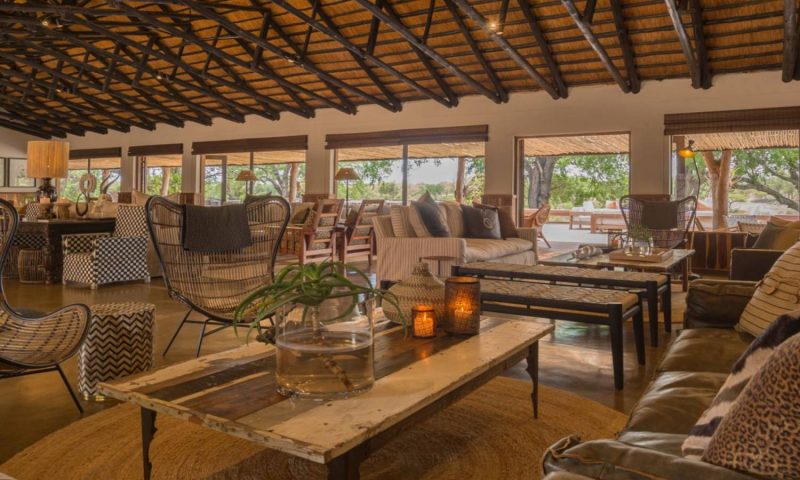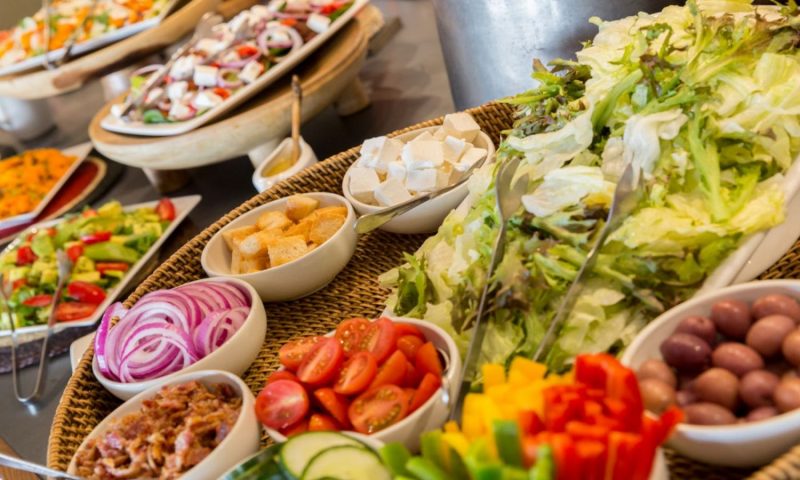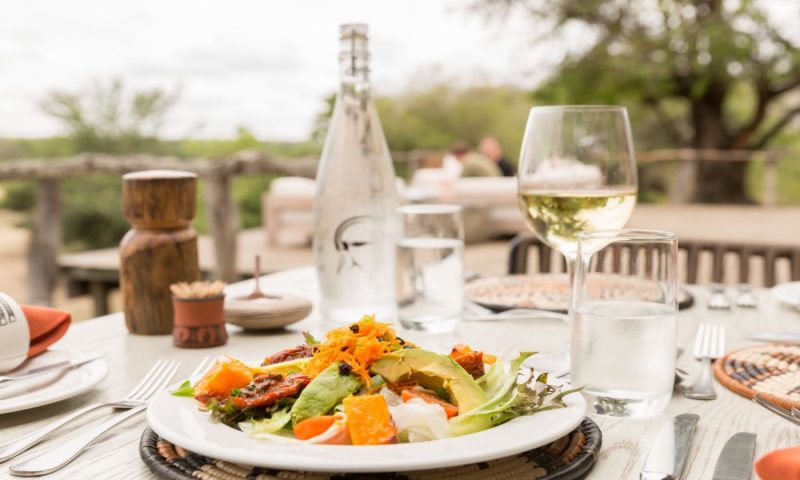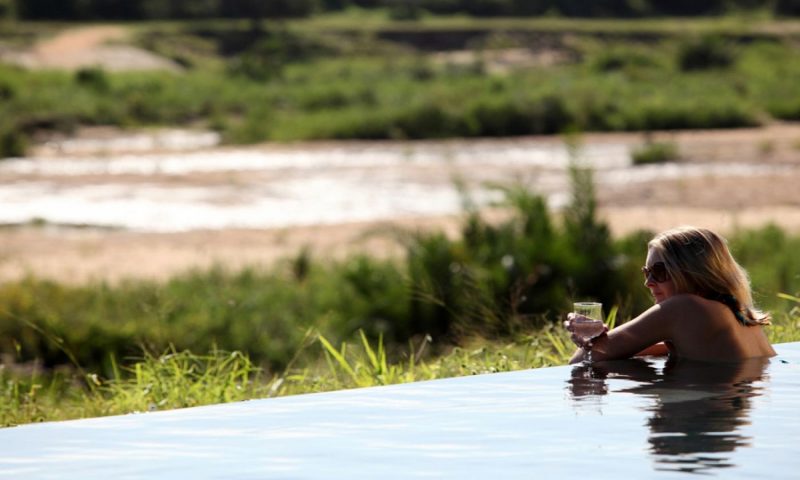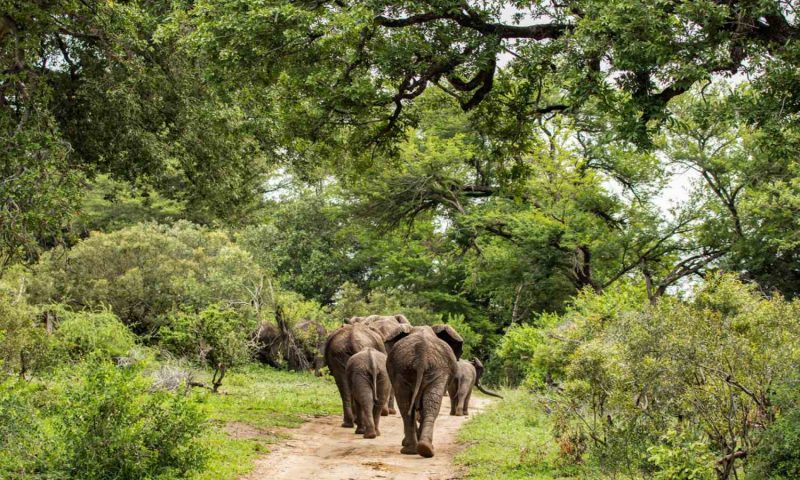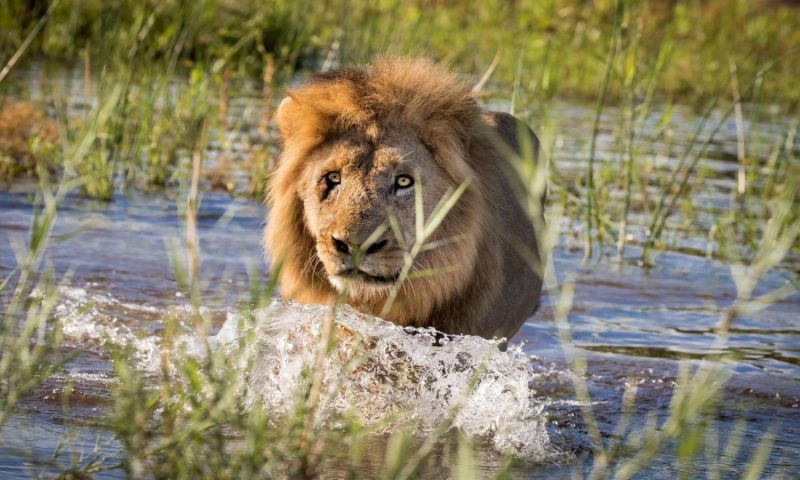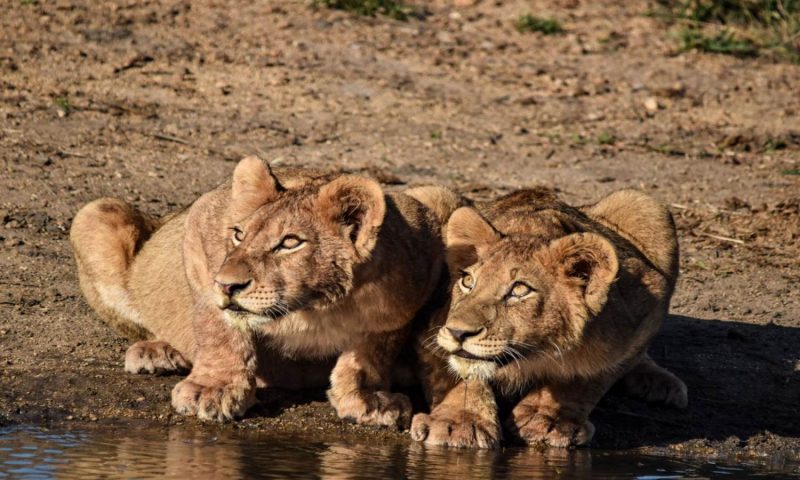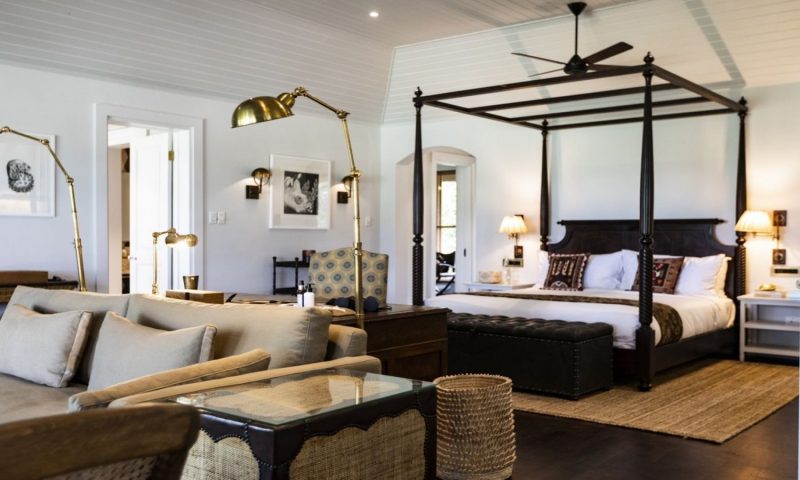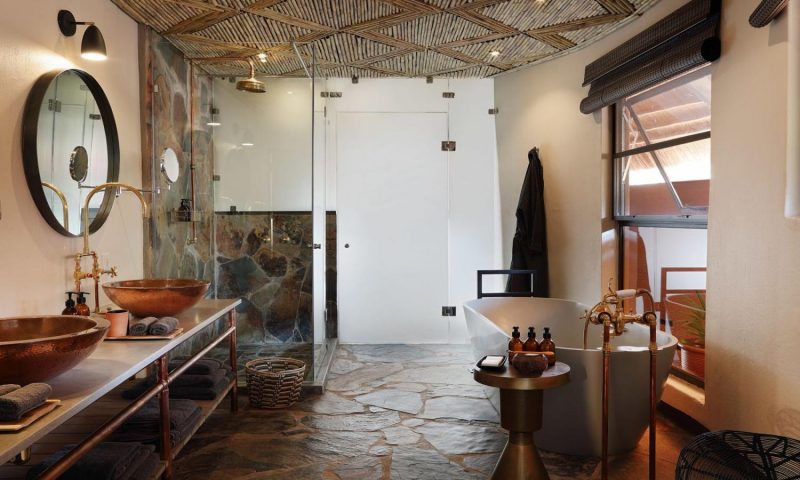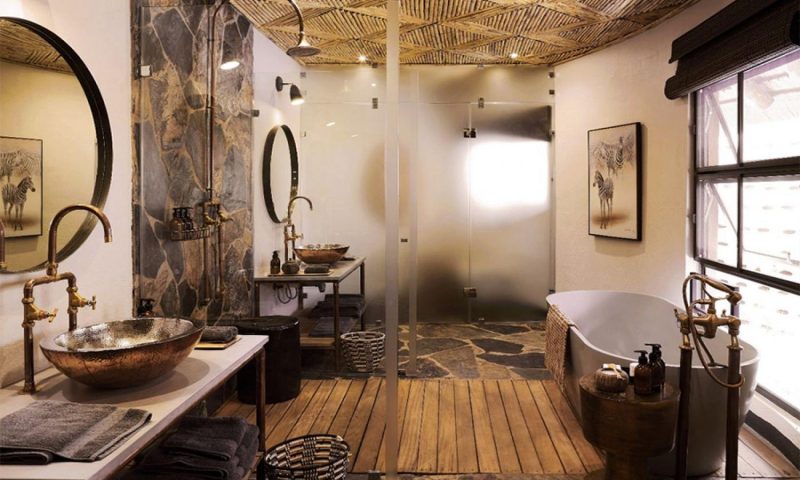MalaMala Game Reserve is the safari industry’s blueprint for the luxury photographic safari. In existence since 1927, this massive, thriving tract of land offers the most exciting wildlife experience this side of the equator. MalaMala Game Reserve is one of the largest private Big Five game reserves in South Africa.
It covers 13 300ha (33 000 acres), shares a 19km (12 mile) unfenced boundary with the world-renowned Kruger National Park and lies strategically sandwiched between the Kruger and the Sabi Sand Reserve.
Importantly, MalaMala has 20 kms (13 miles) of Sand River frontage. This perennial river acts as a magnet for animals in this pristine wildlife area and is the foundation of MalaMala’s unrivalled game viewing and wildlife experience.
Preserving and protecting the environmental integrity of this special piece of Africa has always been at the core of MalaMala’s existence. This philosophy has paid off and international photojournalists and film-makers have made MalaMala their wildlife destination of choice.
MalaMala Sable Camp is a smaller, more intimate version of MalaMala Camp and is ideal for those seeking a more private and secluded safari experience. MalaMala Sable Camp is situated at the southern end of MalaMala Camp in a prime elevated position overlooking the Sand River and surrounding bushveld.
Sable Camp can accommodate a maximum of 20 guests in 7 suites – some of which can accommodate 3 guests sharing. It may also be reserved exclusively for between 14 and 20 guests.
THE WILDLIFE
“Not even Tanzania’s famed Serengeti Game Reserve or the awesome Ngorongoro Crater fills your camera viewfinder faster with Africa’s legendary Big Five – at MalaMala, lion, leopard, buffalo, rhinoceros and elephant appear magically, as if on cue,” says acclaimed wildlife photojournalist Geoff Dalglish in his Sunday Times review.
“Nor could Hollywood script the wide-screen wildlife encounters any more dramatically or frequently than nature does routinely in the private game reserve that is arguably South Africa’s most famous internationally.”
Lion, leopard, elephant, buffalo and rhinoceros are the most sought after and dangerous of the world’s big game. Folklore and legend are rich regarding the Big Five, encompassing beliefs such as: “The Great One put the animals here for us to use wisely and respect, even as we hunted them.
But he knew that without fear we might lose our respect for these creatures, so he put the five here to help us remember. The lion and leopard taught us fear of the night, that only the daytime was ours. The buffalo, the elephant and the rhino taught us to fear their strength, that we might respect the strength of nature.”
THE CHEETAH
The cheetah has a slender, long-legged body with blunt claws that are permanently extended and not protractile, as is the case with the rest of the cat family (cats are frequently but incorrectly described as having “retractable” claws – this would mean that the claws are normally extended and can be retracted at will.
The situation is the reverse, in that the claws are normally sheathed and are extended by will, and the term for this “protractile”.) Black “tear marks” run from the corner of its eyes down the sides of the nose to its mouth. It is said that this prevents the sun from reflecting into its eyes when hunting.
Females reach sexual maturity within 20 to 24 months, and males at around 12 months (although they do not usually mate until at least three years old), and mating occurs throughout the year. Females give birth to up to nine cubs after a gestation period of 90 to 98 days, although the average litter size is three to five.
The mortality rate is very high during the early weeks, and up to 90% of the cubs are killed during this time by lions, hyenas or even by eagles. Cubs leave their mother between 13 and 20 months after birth. Unlike males, females are solitary and tend to avoid each other, though some mother/daughter pairs have been known to continue for small periods of time.
Males are very sociable and will group together for life, usually with their brothers in the same litter. Their ranges are large and their presence in an area unpredictable. One might see cheetahs at MalaMala for periods of up to 22 days in a single month, or go a week or more with no sightings.
The cheetah is a carnivore, eating mostly mammals under 40kg (90lb). While the other big cats mainly hunt by night, the cheetah is a diurnal hunter. It usually hunts either early in the morning or later in the evening when it is not so hot, but there is still enough light.
CAPE HUNTIG DOG
Cape hunting dogs hunt in packs. Their main prey varies among populations, but always focuses on medium-sized ungulates such as impala. Like most members of the dog family, they are cursorial hunters, meaning that they pursue their prey in a long, open chase, rather than relying on stealth as most members of the cat family do.
During pursuit, they may reach speeds of up to 45mph. Typically, about 85% of their hunts result in a kill. Members of a pack vocalise to help coordinate their movements. Their voice is characterised by an unusual chirping or squeaking sound, similar to a bird.
After a successful hunt, dogs regurgitate meat for those that remained at the den during the hunt, such as the dominant female and the pups. Occasionally, they will also feed other pack members, such as very old dogs that cannot keep up.
Wild dogs are endangered, primarily because they occupy huge ranges and consequently can exist only in large wildlife-protected areas. Their hunting method means that, unlike leopards, they are incapable of living unobtrusively and unnoticed in farming areas.
They are strongly affected by competition with larger carnivores that rely on the same prey base, particularly lions and hyenas, and lions are the greatest cause of mortality in wild dogs. There are currently four packs of Cape hunting dogs that frequent our property, some months more regularly than others.
CAPE BUFFALO
Buffalo are large, cattle-like animals. Once widely distributed in Southern Africa, their numbers have been greatly reduced by large-scale hunting and sickness such as rinderpest and foot-and-mouth disease.
Now restricted to the eastern regions of South Africa, they are abundant in the MalaMala area and are frequently seen wallowing in muddy pools or grazing in the vicinity of dams in the reserve.
The buffalo is highly gregarious and usually occurs in large herds, with the largest herd recorded on MalaMala Game Reserve estimated to be in the region of 1 200-plus individuals. Bachelor groups and single animals are also often encountered.
A dominance hierarchy occurs within buffalo herds. The dominant bull or bulls mate with all receptive cows who each produce a single calf after a gestation period of about 11 months.
Although a favourite prey of lions, the large horns and powerful muscles of the buffalo make it a formidable adversary and lions have been known to come off second best in such encounters.
The buffalo is regarded by many as the most dangerous of the Big Five, but this really only pertains to hunting situations. Buffalo kill more hunters than any other member of that group. Left to their own devices and given a comfortable berth they are quite peaceable and will avoid contact with humans, given enough advance notification of their presence.
In dense areas such as reed beds, buffalos can react to being suddenly surprised with a fight rather than flight response, with a potentially fatal encounter for the unfortunate albeit unwise human.
ELEPHANT
The African elephant is the largest land mammal. An adult bull elephant can weigh between 5 000kg and 6 300kg (14 000lb), standing 3.2m to 4m (13ft) at the shoulder. A cow is slightly smaller, weighing 2 800kg to 3 500kg (7 700lb) and standing 2.5m to 3.4m at the shoulder. Bulls usually have larger tusks than cows and a more rounded forehead; the cow is more angled.
The elephant’s tusks are just modified incisor teeth, used as weapons and as an aid in procuring certain foodstuffs, like the bark of trees, for example. The heaviest pair of tusks on record weighed 102.3kg (225lb) and 97kg (213lb) respectively.
Other distinguishing characteristics of elephants are their large ears. These serve as a display function, as well as performing a cooling effect. This is due to a high percentage of blood vessels that cool the blood when the ears are flapped.
The elephant also has a long trunk that it uses to drink and feed. There are 55 000 muscles in an elephant’s trunk, making it an extremely sensitive, prehensile and dextrous appendage, critical to its owner’s survival.
An elephant’s trunk can hold up to 15 litres of water. It uses its trunk to locate food by touch and smell, as an elephant cannot see down its trunk. If an elephant loses the use of its trunk it will die.
Elephants have a wide habitat tolerance. They eat 90% of the plant species in their habitat. An adult elephant may consume up to 300kg (660lb) of food in a day and drink 150 to 200 litres of water. This is due to their being non-ruminants (along with zebras), consequently they digest only about 30% of the food ingested.
Elephant herds are matriarchal, with an older cow leading the herd. The herds are usually family groups of up to 16. However, a number of family groups may congregate at watering sites, forming large herds numbering several hundred.
Adult bulls live separate lives, but will join up with other males and with herds on a temporary basis. After a 22-month gestation period a single calf is born weighing 120kg (264lb) and standing 85cm (34″) at the shoulder.
Elephants live for approximately 60 years and have a large brain capacity. They are intelligent animals, and information necessary for survival, such as the presence of waterholes in times of drought, is memorised by the older members of the herd.
An elephant’s lifespan, apart from poaching and other unnatural forms of death, is governed by its six sets of molars. As one set is worn down it is replaced by another set. This appears to be every 10 years. This process continues until all six sets have been worn down, in which case the animal can no longer chew its food and will starve to death.
Visitors to MalaMala will have noticed a substantial change in elephant numbers over the past 14 years. In 1950, a fence was erected around the Kruger National Park, including its border with MalaMala. This was a six-strand barbed-wire fence, purely to keep animals from mixing with domestic stock and thereby transmitting diseases.
Between 1950 and 1993, when the fence was taken down, only male elephants were seen on MalaMala. The reason for this is surely that females baulked at bringing their calves across or through this obstacle.
Male elephants in this area tend to be found in a state of orbit around the herds, either joining or leaving them, and since there were no herds on the property, the number of males coming across was very small. On average there would be one male elephant found on the property at any one time, at most three.
Since the fence was taken down, herds of females with their calves started being seen. Their numbers were initially very low as they explored this hitherto unavailable tract of land, but over about seven years built up to the point where there were up to 500 elephants on the property at a time.
Perhaps owing to the fact that it is new terrain to them, the density of elephants on the MalaMala Game Reserve and surrounding the Sabi Sand Wildtuin is far higher than within the Kruger Park as a whole, and this clearly has consequences for the environment.
Curiously, the increased number of elephants has not resulted in an increase in camp depredations. Nocturnal incursions into the camps used to be a regular feature before 1993, to the consequent grief of the trees and larger pot plants within. Visitors to MalaMala in the 1980s and early 1990s will doubtless remember an inveterate criminal that raided the camps on a regular basis.
There were many tales of his exploits, but the most curious was the gate that was built for him at the old Harry’s Huts on Toulon. In exiting the camp after molesting the magnificent strangler fig that was the centrepiece of this camp, he broke through the reed wall.
The camp manager at that time ventured the opinion, based on numerous observations, that the elephant did not wish to be destructive but there was no other exit. So he built an elephant-size aperture the next time the wall was rebuilt (with a staggered screen so that it did not look as though there was a hole in it), and ever thereafter the elephant made use of his doorway.
LEOPARD
MalaMala is home to one of the world’s densest leopard populations! On average we view 20 to 25 different individuals every month.
The leopard is by far the most successful large predator in Africa, and arguably the world. Solitary and secretive by nature, leopards are capable of surviving in and around areas of human habitation such as farmland and forestry areas.
Their relatively small size benefits them in this respect, as it reduces their food requirements compared to, for instance, a lion, and also enables them to supplement their principal diet of antelope-sized animals with smaller prey such as hares and even mice.
The smallest prey items recorded are beetles, and the largest is an adult eland. On MalaMala the largest prey items that have been recorded are adult kudus and waterbuck; elsewhere zebras have been taken.
In this area female leopards average 35kg and males 60kg. The maximum weight of a male leopard is probably about 90kg. In the Western Cape, leopards are significantly smaller, with males averaging 32kg and females 20kg, which makes them in many instances smaller than a large male caracal.
LION
Lions are the largest of the social carnivores and live in groups known as prides. A pride consists of between two and 30 related females and cubs residing in a territory. The males have territories of their own, and on average there will be three prides of females within their territory.
Dominant males patrol the borders of their territory, scent-marking and roaring to advertise their presence. Contrary to popular belief, they hunt for themselves, though are certainly not averse to monopolising kills made by the prides in their area, should they encounter them.
The mane of the lion probably serves to increase its apparent size. Dominant males are usually found in coalitions; a single male will struggle to defend a territory against two or more other males. These coalitions are invariably litter-mates who have grown up together.
There are presently four prides and three male coalitions that we view on a regular basis on MalaMala, as well as other prides, coalitions and nomadic young males that come onto our property from time to time. Prides: Kambula, Eyrefield, Torchwood, Marthly, Styx and Fourways. Coalitions: Avoca males and Gowrie males.
The commonly accepted perception of a pride consisting of a number of females and a single male is therefore not accurate, yet this situation can pertain to the case of a male who has lost the other member or members of his coalition.
It would appear that in this circumstance he will join a pride for the protection in numbers that it affords. This has recently occurred with the Sand River pride and the Toulon male. Male lions are in their prime from five to eight years of age. Successful males can live for as long as 14 years, although rarely do. Unsuccessful ones might not even make seven.
Females whose cubs have been killed by newly territorial males come into oestrus again quickly. Females in a pride often synchronise their oestrus, so the litters of between one and five cubs are born at much the same time. The cubs are then reared communally and suckled indiscriminately by any female.
The cubs weigh only 1kg to 2kg at birth and are as helpless as kittens, opening their eyes after three to 11 days. After four to 8 weeks the mother may lead the cubs to nearby kills, although they are only weaned at seven to 10 months. Cub mortality is high, especially if hunting is scarce.
Hunting is conducted almost entirely at night when their mostly monochromatic vision, which distinguishes between light and dark, gives them an advantage over their prey’s colour vision. Nights when it is full moon are not conducive to successful hunting.
Hunting is a group effort – whether there is any communication and tactics involved or mere instinct is debatable. Extensive observations at MalaMala show that when prey is detected, one lion will immediately lie down, while the other or others circle around.
In this manner, when a lion eventually makes its move, there is a likelihood of the prey running into an ambush. Lions are, however, possessed of a degree of intelligence and are capable of learning from experience, so the possibility of deliberate cooperative hunting techniques arising in particular individuals cannot be discounted.
An extensive study by Butch Smuts in the adjoining Kruger National Park has given us accurate weights – he found that female lions average 125kg, and males 180kg. The largest male lion that he recorded weighed in at 240kg.
A DAY AT MALAMALA
On arrival at the camps in the reserve, guests are introduced to their ranger, who acts as host, guide and educator. While an itinerary is suggested to take advantage of the more comfortable temperature ranges and the enhanced game-viewing opportunities, it is also important to take time to relax and enjoy the camp surroundings, and to immerse oneself in the environment.
The itineraries below are not set in stone. Guests are encouraged to discuss their preferences with their ranger on arrival, and everything possible will be done to accommodate them within the confines of the camp routine, and with consideration to safari companions sharing the same ranger and vehicle. For those not keen on an early-morning wake-up call, a later departure can be arranged from the camp to meet up with the early-morning drive.
SUMMER ITINERARY (MAY TO SEPTEMBER)
- 05h30 – Wake-up call by your ranger heralds the dawn.
- 06h00 – Meet your ranger and safari companions on the safari deck as the sun rises over the bushveld. Hot and cold beverages and a light snack are available. The early-morning game drive follows.
- 09h30 – Return to camp where a hearty brunch awaits you in the air-conditioned dining room or on the expansive safari deck. For the more energetic, join the bush walk after brunch. Alternatively, relax around the pool, browse through the safari boutique, work out in the small gym or perhaps take a siesta to make up for that early-morning wake-up call. Feel free to explore the camp but please do not walk beyond the camp perimeters unless accompanied by a ranger.
- 15h00 – Meet on the expansive safari deck for hot and cold beverages and a light snack before departing on another unforgettable safari. A cooler box with the veritable sundowners are carried on the Land Rover, and a consensus among your fellow safari-ites will determine whether a G & T is worth more than a leopard sighting! As darkness approaches, your ranger will scan the bush with a powerful spotlight and will point out elusive nocturnal wildlife – a highlight of the day’s safari. As darkness settles over the bush, look out for the Milky Way and try to find the Southern Cross.
- 20h00 – Return to camp, allowing time for you to freshen up before meeting your friends and rangers for pre-dinner drinks in the cosy Safari Bar.
- 20h30 – Dinner is served in the reed-enclosed boma under an ancient jackalberry tree. Alternatively, when the weather is suitable, a candlelit dinner is served on the safari deck overlooking the Sand River. While seated around a log fire under the starry African sky, enjoy the superb food and excellent wines – yet another highlight of the MalaMala experience.
WINTER ITINERARY (JUNE TO AUGUST)
- 06h30 – Wake-up call by your ranger heralds the dawn.
- 07h00 – Meet your ranger and safari companions for early morning snacks and coffee. The morning game drive follows.
- 10h00 – Return to camp for brunch. You are now able to relax around the pool, work out in the gym, browse through the safari boutique or perhaps take a siesta to make up for the early-morning wake-up call. Feel free to explore the camp but please do not walk beyond the camp perimeters unless accompanied by a ranger.
- 15h00 – Meet on the expansive safari deck for hot and cold beverages and a light snack before departing on another unforgettable safari. A cooler box with the veritable sundowners are carried on the Land Rover, and a consensus among your fellow safari-ites will determine whether a G & T is worth more than a leopard sighting! An African sunset is a memorable and often emotional sight. As darkness approaches, your ranger will scan the bush with a powerful spotlight and will point out elusive nocturnal wildlife – a highlight of the day’s safari. As darkness settles over the bush, look out for the Milky Way – a truly spectacular sight – or try to find the Southern Cross.
- 19h00 – Return to camp, allowing time for you to freshen up before meeting your friends and rangers for pre-dinner drinks in the cosy Safari Bar and a delicious dinner in the reed-enclosed boma under an ancient jackalberry tree. While seated around a log fire under the starry African sky, enjoy the superb food and excellent wines – yet another highlight of the MalaMala experience. Alternatively, when the weather is suitable, a candlelit dinner is served on the safari deck overlooking the Sand River.
PHOTOGRAPHIC EXPERIENCE
MalaMala Game Reserve offers some of the very best wildlife photographic opportunities on the planet. “Over the past 10 years I’ve travelled the world documenting wildlife for National Geographic but nothing has compared to what MalaMala has to offer.
Nowhere in Africa can the scenic beauty and wildlife behaviour be remotely compared to MalaMala in any aspect and it’s hands down the most remarkable place I have ever filmed in.” Russell MacLaughlin – Nat Geo Wild
The photographic experience includes a dedicated ranger to guide you through your safari. Their intuitive knowledge of animal behaviour and skilled positioning of the vehicle affords one enhanced wildlife photographic opportunities.
This, coupled with the option of either a sliding, cushioned camera rail or a fixed, cushioned camera rail, affords one the greatest comfort and stability when attempting to capture those quintessential wildlife images you’ve been waiting for.
The photographic experience can be booked for individuals, families or small groups travelling together. It is ideal for both enthusiastic amateurs as well as seasoned veterans.
CHILDREN’S PROGRAMME
MalaMala Camp welcomes children of all ages. Children under 12 sharing accommodation with full-paying adults pay the quoted child tariff. A number of family rooms are available which can accommodate an extra bed for a triple share or 2 extra beds for a quad share.
We also have 2 sets of interleading rooms with a sleeper couch for a 5thperson. Please liaise with our central reservations office for the availability of the family friendly units. Children aged five and under are not permitted to dine in the boma in the evenings.
Special dining arrangements can be made and babysitting services provided on request, at a nominal charge. Children aged five and under are unable to join game drives, unless their parents/party have reserved exclusive use of a game-drive vehicle at an additional cost – please discuss this with our reservations consultants.
A MalaMala backpack, which includes an interactive checklist, bird and mammal colouring books, lip ice and water, is given to each child between the ages of four and 12
THE HISTORY
“I was all of five, but I shall never forget that five-day car journey in 1937, when I accompanied my parents from Zululand via Swaziland to the Lowveld, which adjoins Skukuza in the Kruger National Park. The petrol tank of my father’s Cadillac kept scraping against the ridged, dirt roads, which caused it to leak and to require constant plugging with ‘blue mottle’ soap!
All very exasperating for him – more so when his two Doberman Pinschers killed all the laying hens in the supplies lorry, loaded with our provisions for the next two months.
I’m not musical, but to pass the time I blew tunelessly into my ‘mouth organ’, severely adding to my father’s irritation. He eventually grabbed the instrument and threw it into the veld of Swaziland, prompting me to howl for hours.
“Those were the days when hunters shot many animals without a conscience. Fortunately these same species now roam the MalaMala Game Reserve unhindered, and the flora and fauna are well protected for posterity, too.
Today MalaMala boasts one of the greatest wildlife diversifications in Africa and thrilling game viewing that consistently draws nature lovers from across the globe – as well as some of the world’s most respected wildlife photographers and film-makers.” – Michael Rattray
The Sabi Game Reserve was proclaimed in 1902. In area, it was roughly twice the size of the present Kruger National Park. Some of the area was used as grazing by farmers, and game laws were nebulous – farmers were allowed to shoot game in defence of their livestock (an arrangement far from ideal from a conservation point of view).
In 1922 the farm MalaMala was acquired by the Transvaal Consolidated Land and Exploration Company (TCL); later, 800 cattle were shipped to Toulon by rail. In the next six years, managers from TCL were to shoot over 500 lions in defence of their cattle.
This was before the untenable shortfalls of farming cattle in the arid and disease- and lion-infested Transvaal Lowveld were finally acknowledged.
The National Parks Act was passed in 1926. The Sabi Game Reserve was effectively reduced by about half, resulting in the Kruger National Park in its current form (devoid of human occupancy, and governed purely by conservation principles).
The land to the west was now open to private ownership. The land had proven useless for farming; however, its value as a wildlife haven was being recognised, and individuals bought properties to be used privately for game viewing, relaxation and hunting.
In 1927 William Campbell (affectionately known as Wac) bought Eyrefield for £2 150, and in 1929 MalaMala for £3 656 pounds. Loring Rattray, Michael’s father, bought the adjacent Exeter in 1937, and Wallingford in 1939.
The site of Wac’s first MalaMala camp was in the area where the Mlowathi River flows into the Sand River. It was soon found that the rains made the river difficult to ford, and in 1930 the camp was moved to its present site, on the western banks of the river.
It was used exclusively in winter as a base from which to hunt. But even then, guests were treated like royalty. And royalty (such as Princess Alice and her husband, the Earl of Athlone) were often guests.
Lady Campbell visited MalaMala for the first time in 1935. She embarked immediately on the task of transforming the camp, planting the bougainvillea that has become known as MalaMala’s signature bloom. Today still sees the shock of pink growing abundantly along the camp’s immaculately swept pathways.
In 1960 Wac submitted his last game report. For more than 30 years he had carefully observed and recorded what had transpired in the field. In that last report, he noted that warthog were now fortunately on the increase, while sable antelope were on the decline.
He mentioned at the end of his report that 130 guests had enjoyed MalaMala that season, more than half of these having been women and children (a new development). Wac signed the report as “Colonel” and was never to return to MalaMala.
Two years later, on 17 September 1962, Wac died and MalaMala passed to his son, Urban. The camera replaced the gun and Africa’s first photographic safari destination was born. Urban sold MalaMala in 1964 to a company named MalaMala Ranch (Pty) Ltd – the shares of which belonged to Michael Rattray.
In 1970 MalaMala was described by TV Bulpin’s Discovering Southern Africa as “luxurious accommodation for up to 22 people. Tariff R30.00 per day” (which seemed a very high tariff when you consider that five-star hotels were charging R12 bed and breakfast).
In November 2013, in a ground-breaking land restitution transaction, the South African Government acquired MalaMala’s ‘land and buildings’ from Michael Rattray and transferred the ownership thereof to the claimant community, represented by the Nwandlamhari Communal Property Association (CPA).
In March 2016, following an appropriate transitional period, Mr Michael Rattray, Mr Stephen Saad and the Nwandlamhari Communal Property Association entered into a long-term co-management agreement for the management and operation of the MalaMala Game Reserve business.
